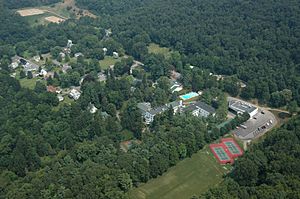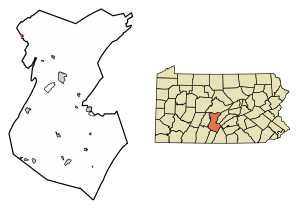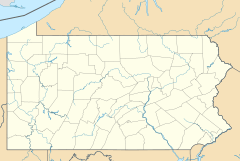Birmingham, Huntingdon County, Pennsylvania facts for kids
Quick facts for kids
Birmingham, Pennsylvania
|
|
|---|---|
|
Borough
|
|

Grier School and the Borough of Birmingham
|
|

Location of Birmingham in Huntingdon County, Pennsylvania.
|
|
| Country | United States |
| State | Pennsylvania |
| County | Huntingdon |
| Settled | 1797 |
| Incorporated | 1828 |
| Government | |
| • Type | Borough Council |
| Area | |
| • Total | 0.06 sq mi (0.16 km2) |
| • Land | 0.06 sq mi (0.16 km2) |
| • Water | 0.00 sq mi (0.00 km2) |
| Elevation | 965 ft (294 m) |
| Population
(2020)
|
|
| • Total | 89 |
| • Density | 1,412.70/sq mi (547.09/km2) |
| Time zone | UTC-5 (Eastern (EST)) |
| • Summer (DST) | UTC-4 (EDT) |
| Zip code |
16686
|
| Area code(s) | 814 |
| FIPS code | 42-06560 |
| GNIS feature ID | 1215265 |
| School District: | Tyrone Area School District |
| Local phone exchanges: 682, 684, 686 | |
Birmingham is a small town, also called a borough, located in Huntingdon County, Pennsylvania. In 2020, about 90 people lived there. It's a quiet place with a rich history.
Contents
History of Birmingham
Birmingham is known for a special rock formation called the Birmingham Window. This formation was created by a very old thrust fault, which is like a giant crack in the Earth's crust where rocks have been pushed over each other.
Early Settlers and Growth
The first person to settle here was John Cadwallader. He arrived in 1797 and built his home on a hill overlooking the Little Juniata River. He had big plans for the area, hoping it would grow into a large city.
In the early 1800s, Birmingham became a busy center for trade. Goods were moved along the Little Juniata River and the nearby Pennsylvania Canal. This helped the village grow quickly.
The Railroad Era
Around 1850, the Pennsylvania Railroad was built through the valley. This changed things for Birmingham. Nearby towns like Tyrone and Altoona had land that was better for building big railroad centers. Because of this, Birmingham became less important as a trading hub.
The Grier School
In 1853, a boarding school for girls called the Mountain Female Seminary opened in Birmingham. The new railroad made it easy for students to travel to the school. Today, this school is still open and is known as Grier School. It continues to be a boarding school for girls.
Recent Events
On August 23, 2011, an earthquake on the East Coast caused a rockslide along Route 453 in Birmingham.
Geography
Birmingham is a very small borough. According to the United States Census Bureau, its total area is about 0.06 square miles (0.16 square kilometers). All of this area is land, with no water.
Population Information
| Historical population | |||
|---|---|---|---|
| Census | Pop. | %± | |
| 1820 | 43 | — | |
| 1840 | 235 | — | |
| 1850 | 266 | 13.2% | |
| 1860 | 221 | −16.9% | |
| 1870 | 263 | 19.0% | |
| 1880 | 231 | −12.2% | |
| 1890 | 225 | −2.6% | |
| 1900 | 240 | 6.7% | |
| 1910 | 196 | −18.3% | |
| 1920 | 197 | 0.5% | |
| 1930 | 191 | −3.0% | |
| 1940 | 198 | 3.7% | |
| 1950 | 178 | −10.1% | |
| 1960 | 136 | −23.6% | |
| 1970 | 115 | −15.4% | |
| 1980 | 121 | 5.2% | |
| 1990 | 109 | −9.9% | |
| 2000 | 91 | −16.5% | |
| 2010 | 90 | −1.1% | |
| 2020 | 90 | 0.0% | |
| 2021 (est.) | 89 | −1.1% | |
| Sources: | |||
As of the census in 2010, there were 90 people living in Birmingham. These people lived in 42 different homes. The population density was about 900 people per square mile.
Most of the people living in Birmingham were White, making up about 97.78% of the population. A small number were Asian (1.11%) or from other races (1.11%). About 6.67% of the population identified as Hispanic or Latino.
In terms of households, about half were married couples living together. Some households had children under 18. The average household had about 2.33 people.
The population included people of all ages. About 15.6% were under 18 years old, and 20% were 65 years or older. The average age of people in Birmingham was 40 years old. Slightly more than half of the population were females (51.11%), and the rest were males (48.89%).
Images for kids
See also
 In Spanish: Birmingham (condado de Huntingdon, Pensilvania) para niños
In Spanish: Birmingham (condado de Huntingdon, Pensilvania) para niños





